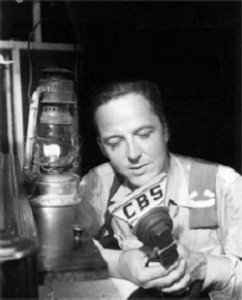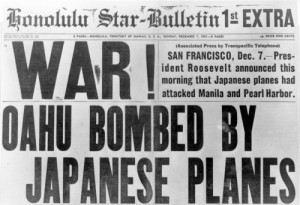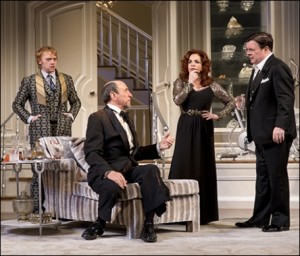 “Sarcasm I now see to be, in general, the language of the Devil; for which reason I have, long since, as good as renounced it.”
“Sarcasm I now see to be, in general, the language of the Devil; for which reason I have, long since, as good as renounced it.”
Thomas Carlyle, Sartor Resartus
Terry Teachout on the arts in New York City
I’ve been reading Steven M. Gillon’s Pearl Harbor: FDR Leads the Nation into War, an exceptionally fine monograph about what happened during the twenty-four hours that followed the Japanese attack on Pearl Harbor. One of the parts that I found most fascinating was Gillon’s description of how and when the American public found out about what happened in Hawaii.
 The first wire-service bulletin, “Washington—White House announces Japanese have attacked Pearl Harbor,” was transmitted by United Press International at 2:25 p.m. on December 7, 1941, half an hour after President Roosevelt got the news at the White House. NBC broadcast it four minutes later, and CBS followed suit at 2:31. But it seems to have taken longer—infinitely longer, by postmodern standards—for the average American to learn about Pearl Harbor. Not for another two and a half hours did major newspapers publish “extra” editions reporting the attack, and it took even longer for those editions to reach the street.
The first wire-service bulletin, “Washington—White House announces Japanese have attacked Pearl Harbor,” was transmitted by United Press International at 2:25 p.m. on December 7, 1941, half an hour after President Roosevelt got the news at the White House. NBC broadcast it four minutes later, and CBS followed suit at 2:31. But it seems to have taken longer—infinitely longer, by postmodern standards—for the average American to learn about Pearl Harbor. Not for another two and a half hours did major newspapers publish “extra” editions reporting the attack, and it took even longer for those editions to reach the street.
According to Gillon:
Only a small number of Americans were listening to the radio when the first Pearl Harbor announcements were made. In the 1940s, it was typical for middle-class Americans to eat dinner around 1:00 p.m. on Sundays. Many families living in the East and Midwest were gathered around the dinner table or relaxing after a big meal. Most of the nation was also experiencing nice weather on December 7. More people than usual were outside, going for afternoon drives in the country, walking in the park, attending football games, or catching a matinee at the local movie theater….
A reporter for the Kansas City Times reported that the city maintained “a business-as-usual calm” in the hours after the story broke. The main reason, he speculated, was that most people did not learn of the attack until the newspaper boys started shouting the headline on Sunday evening as they pushed late editions on street corners.
When President Kennedy was assassinated in 1963, by contrast, pollsters later reported that “92% of the [American] public knew what had happened within two hours of the shooting.” I was seven years old, and my elementary school dismissed all classes immediately after his death was reported. The family TV set (we only had one) was on when I got home, and it stayed on for most of the rest of the weekend.
 Today breaking news spreads even faster via a much larger number of “channels,” Twitter prominent among them. Hence we take it for granted that when something important happens in the world, we’ll know about it right away, one way or another. But America moved more slowly in 1941, partly because the technology to speed it up did not yet exist and partly—maybe mostly—because ordinary Americans seem to have felt that nothing in the world, not even a surprise attack on Pearl Harbor, was so important that it couldn’t wait.
Today breaking news spreads even faster via a much larger number of “channels,” Twitter prominent among them. Hence we take it for granted that when something important happens in the world, we’ll know about it right away, one way or another. But America moved more slowly in 1941, partly because the technology to speed it up did not yet exist and partly—maybe mostly—because ordinary Americans seem to have felt that nothing in the world, not even a surprise attack on Pearl Harbor, was so important that it couldn’t wait.
Back then, of course, the world really was bigger, immeasurably so. Our collective anxiety over the spread of Ebola is not an artifact of round-the-clock coverage by the cable news networks but a function of our collective awareness that an outbreak of disease in Africa can reach any part of the United States via the next transcontinental flight. Even so, the intensity of that anxiety has been fed by the ubiquity of web-based news—or, rather, “news,” since what we hear on Twitter may or may not be true.
Like everyone else who has lived on both sides of the information-technology chasm, I have mixed feelings about the wired world into which I have survived. Most of the time I happily side with its strengths, but there was also much to be said for a culture in which we were not required to live in a continuous now. On December 7, 1941, the American people had a fair amount of time to get used to the idea of being at war. They went to church that morning, came home and ate their Sunday dinners, took a peaceful afternoon nap, then turned on the radio to listen to The Jack Benny Program. They heard it, too, though Benny’s regular broadcast was interrupted twice for war-related news bulletins. It wasn’t until the following afternoon that FDR’s voice was finally heard on the radio, when he went before a joint session of Congress to ask for a declaration of war on Japan.
By then America was reasonably ready to grapple with the new reality that lay dead ahead. Nowadays, by contrast, we’re expected to grapple with new realities mere minutes after they happen. Small wonder that our responses to them are becoming increasingly reflexive and superficial. The world expects too much of us, and we are, I suspect, doomed to disappoint.
* * *
Listen to NBC’s first Pearl Harbor bulletin here.
Listen to the December 7 episode of The World Today, CBS’ regular Sunday-afternoon news broadcast, here.
Listen to the December 7 episode of The Jack Benny Program here.
FDR addresses a joint session of Congress on December 8:
The first hour of CBS’ coverage of the assassination of President Kennedy on November 22, 1963:
 Frank Sinatra sings “Lonely Town” on The Frank Sinatra Show in 1958. The song, by Leonard Bernstein, Betty Comden, and Adolph Green, is from On the Town. The arrangement, by Gordon Jenkins, was originally recorded in 1957 and released on Sinatra’s album Where Are You? A revival of On the Town opens on Broadway this week:
Frank Sinatra sings “Lonely Town” on The Frank Sinatra Show in 1958. The song, by Leonard Bernstein, Betty Comden, and Adolph Green, is from On the Town. The arrangement, by Gordon Jenkins, was originally recorded in 1957 and released on Sinatra’s album Where Are You? A revival of On the Town opens on Broadway this week:
(This is the latest in a series of arts-related videos that appear in this space each Monday and Wednesday.)
In today’s Wall Street Journal drama column I review two Broadway openings, The Curious Incident of the Dog in the Night-time and It’s Only a Play. Here’s an excerpt.
* * *
Asperger Syndrome is a very real and at times devastatingly serious mental disorder, but it also has a parallel life as what can only be described as a pop-culture phenomenon. (Serial murder and gluten intolerance fall into the same double-barreled category.) This explains some, if by no means all, of the popularity of “The Curious Incident of the Dog in the Night-time,” Mark Haddon’s best-selling 2003 children’s novel about a teenaged math prodigy whose obsessive-compulsive behavior and emotional inaccessibility drive a wedge into his parents’ marriage. Simon Stephens turned it into a play two years ago, and it has now moved to Broadway after a successful run in London.
 What works about Mr. Stephens’ play is that for most of its length, it paints an unprettified picture of the havoc that Asperger and other autism spectrum disorders can wreak, both on those who suffer from them and on their families as well. Not until the last scene, when “The Curious Incident of the Dog in the Night-time” suddenly loses altitude and gets sentimental, does it fail to be honest about the plight of Christopher (Alex Sharp), who is so detached from his feelings that when his father (Ian Barford) tells him that his mother (Enid Graham) has just died of a heart attack, his only response is “What kind of heart attack?” Anyone who has seen the dire effects of such disorders up close will be dazzled (if that’s the word) by Mr. Sharp’s performance, which is accurate to the last agonizing detail. In addition, Marianne Elliott has staged “Curious Incident” with quick fluidity and a pleasing knack for visual fantasy…
What works about Mr. Stephens’ play is that for most of its length, it paints an unprettified picture of the havoc that Asperger and other autism spectrum disorders can wreak, both on those who suffer from them and on their families as well. Not until the last scene, when “The Curious Incident of the Dog in the Night-time” suddenly loses altitude and gets sentimental, does it fail to be honest about the plight of Christopher (Alex Sharp), who is so detached from his feelings that when his father (Ian Barford) tells him that his mother (Enid Graham) has just died of a heart attack, his only response is “What kind of heart attack?” Anyone who has seen the dire effects of such disorders up close will be dazzled (if that’s the word) by Mr. Sharp’s performance, which is accurate to the last agonizing detail. In addition, Marianne Elliott has staged “Curious Incident” with quick fluidity and a pleasing knack for visual fantasy…
What’s wrong with Ms. Elliott’s production, which is a remounting of the original National Theatre staging, is that she smothers the play in fantastically elaborate video projections designed by Finn Ross whose purpose is to suggest the sensory overload that can overwhelm people like Christopher when they try to explore the chaotic world outside their heads. The virtuosity of these effects gets in the way of the viewer’s imaginative participation in Christopher’s inner life, which Mr. Sharp is more than capable of evoking on his own….
 Thanks to the monetizable presences of Nathan Lane and Matthew Broderick, the Broadway debut of Terrence McNally’s “It’s Only a Play,” a 1982 comedy set at the opening-night party for an unsuccessful play, is already the hottest ticket in town—and rightly so. This revival, which also stars F. Murray Abraham (who has great fun playing a suppuratingly self-important drama critic), Stockard Channing (who steals the show as a washed-up, coke-snorting movie star), Rupert Grint and Megan Mullally and is directed with cattle-prodding energy by Jack O’Brien, is as funny as the new Broadway revival of “You Can’t Take It With You” tries too hard to be.
Thanks to the monetizable presences of Nathan Lane and Matthew Broderick, the Broadway debut of Terrence McNally’s “It’s Only a Play,” a 1982 comedy set at the opening-night party for an unsuccessful play, is already the hottest ticket in town—and rightly so. This revival, which also stars F. Murray Abraham (who has great fun playing a suppuratingly self-important drama critic), Stockard Channing (who steals the show as a washed-up, coke-snorting movie star), Rupert Grint and Megan Mullally and is directed with cattle-prodding energy by Jack O’Brien, is as funny as the new Broadway revival of “You Can’t Take It With You” tries too hard to be.
Mr. McNally has revised “It’s Only a Play,” transplanting it into our latter-day cyberworld of selfies and chatrooms and updating the topical references (“Annie” is out, “Matilda” in). It might have worked just as well as a period piece, in much the same way that “The Man Who Came to Dinner” is now a time capsule of America’s nascent celebrity culture circa 1939. Given the results, though, why complain?…
* * *
To read my review of The Curious Incident of the Dog in the Night-time, go here.
To read my review of It’s Only a Play, go here.
In today’s Wall Street Journal “Sightings” column I take a look at the Library of America, and speculate on how some (if not all) of its recent volumes reflect a growing trend in American culture. Here’s an excerpt.
* * *
 Virgil Thomson’s “Music Chronicles 1940-1954,” one of the latest titles from the Library of America, is an indispensable collection, perfectly edited by Tim Page, of the journalistic writings of the most important American music critic of the 20th century. Thomson was one of the few members of his much-maligned profession to have also had success as a creative artist, though his brilliantly witty reviews were, if anything, even more consequential than his musical compositions….
Virgil Thomson’s “Music Chronicles 1940-1954,” one of the latest titles from the Library of America, is an indispensable collection, perfectly edited by Tim Page, of the journalistic writings of the most important American music critic of the 20th century. Thomson was one of the few members of his much-maligned profession to have also had success as a creative artist, though his brilliantly witty reviews were, if anything, even more consequential than his musical compositions….
The Library of America, it seems, is on a roll. In September, for instance, it brought out a long-overdue omnibus edition of “Happy Days,” “Newspaper Days” and “Heathen Days,” H.L. Mencken’s three volumes of autobiographical essays, and it has just published “Art in America 1945-1970: Writings from the Age of Abstract Expression, Pop Art and Minimalism,” an immaculately well-chosen anthology put together by Jed Perl. All three volumes live up to the mission statement printed on their dust jackets, in which the LOA declares itself to be “dedicated to preserving America’s best and most significant writing.”
That’s why I’ve boggled at certain other authors who have received the Library of America imprimatur in recent years. First it was Philip K. Dick, a science-fiction writer of moderate renown (he wrote the novel on which the film “Blade Runner” was based) who specialized in paranoid fantasies about parallel universes. Then came Kurt Vonnegut, author of the best-selling “Slaughterhouse-Five,” which was beloved of baby-boom sophomores who fancied themselves countercultural but is not, so far as I know, taken very seriously by anyone else nowadays. Most recently, the popular crime novelist Elmore Leonard got the nod.
Not being privy to the decision-making processes of the LOA’s executives, I can’t say what they were thinking when they implicitly declared the aforementioned gentlemen to be worthy of the company of (to pick at random) Willa Cather, Robert Frost, Henry James, Herman Melville, Flannery O’Connor, Philip Roth and Thornton Wilder, all of whom figure prominently on their backlist. II think it likely, however, that multiple factors were in play, among them the desire to keep up with the current literary fashion for “inclusivity” and a healthy respect for the bottom line. (The LOA brags in its latest mailing that one of its three Vonnegut volumes was the best-selling title on its backlist last year.) All of which makes you wonder who else might be under consideration these days. Woody Allen? Stephen King? Mickey Spillane?
On the other hand, the inclusion of Messrs. Dick, Leonard and Vonnegut is surely as reflective of the same cultural sea change that is no less clearly evident in the evolution—or, rather, devolution—of the Kennedy Center Honors. In 1978, the first five recipients of that once-prestigious award were Marian Anderson, Fred Astaire, George Balanchine, Richard Rodgers and Arthur Rubinstein. This year’s honorees will be Al Green, Tom Hanks, Lily Tomlin and Sting, with the peerless ballerina Patricia McBride thrown in to humor the highbrows….
* * *
Read the whole thing here.
Here’s my list of recommended Broadway, off-Broadway, and out-of-town shows, updated weekly. In all cases, I gave these shows favorable reviews (if sometimes qualifiedly so) in The Wall Street Journal when they opened. For more information, click on the title.
BROADWAY:
• Cabaret (musical, PG-13/R, closes Jan. 4, reviewed here)
 • The Country House (drama, PG-13, most performances sold out last week, closes Nov. 9, reviewed here)
• The Country House (drama, PG-13, most performances sold out last week, closes Nov. 9, reviewed here)
• A Gentleman’s Guide to Love & Murder (musical, PG-13, nearly all performances sold out last week, reviewed here)
• Love Letters (drama, PG-13, closes Feb. 1, reviewed here)
• Matilda (musical, G, reviewed here)
• Les Misérables (musical, G, too long and complicated for young children, reviewed here)
• Once (musical, G/PG-13, closes Jan. 4, reviewed here)
• This Is Our Youth (drama, PG-13, closes Jan. 4, reviewed here)
OFF BROADWAY:
• The Fatal Weakness (drama, PG-13, closes Oct. 26, reviewed here)
• The Fantasticks (musical, G, suitable for children capable of enjoying a love story, reviewed here)
• Indian Ink (drama, PG-13, closes Nov. 30, reviewed here)
IN NIAGARA-ON-THE-LAKE, ONTARIO:
• When We Are Married (comedy, PG-13, closes Oct. 26, reviewed here)
IN SPRING GREEN, WIS.:
• American Buffalo (drama, PG-13, closes Nov. 8, reviewed here)
CLOSING NEXT WEEK IN NIAGARA-ON-THE-LAKE, ONTARIO:
• Arms and the Man (comedy, G/PG-13, closes Oct. 18, reviewed here)
CLOSING SUNDAY IN NIAGARA-ON-THE-LAKE, ONTARIO:
• The Sea (black comedy, PG-13, reviewed here)
An ArtsJournal Blog